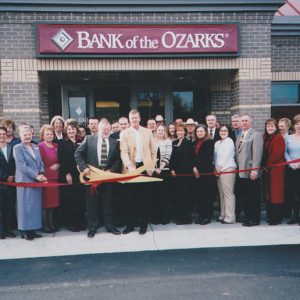calsfoundation@cals.org
Bank OZK
Bank OZK grew from a small-town bank in Ozark (Franklin County) to have offices in ten states by 2019, also becoming a major lender for commercial construction projects in metropolitan centers throughout the country. The bank was recognized thirteen times from 2011 to 2019 as the top-performing bank in the nation by various trade publications. It has maintained significant profitability through all economic cycles and has rewarded its stockholders through stock price appreciation and increasing dividends.
In 1979, George Gleason, a twenty-five-year-old attorney with the Rose Law Firm in Little Rock (Pulaski County), purchased the small Bank of Ozark. He left law practice and moved to Ozark and took over bank management as chairman and CEO. The bank, which had been chartered in 1937, had assets of $28 million and twenty-eight employees. Gleason purchased the Newton County Bank in Jasper (Newton County) in 1983 and merged the charters, thus giving the bank a history dating to 1903.
By 1994, the bank had added five branches and grown significantly, and the name was changed to Bank of the Ozarks. The headquarters was moved to Little Rock in 1995, and in 1997, the then-$300 million-asset bank had its initial public offering of stock. In 1998, the bank constructed a 40,000-square-foot building on Chenal and Markham for its company headquarters.
After opening branches in the larger cities in Arkansas, the bank began its out-of-state expansion. A loan production office was opened in Charlotte, North Carolina, in 2001. In 2003, an office was opened in Dallas, Texas, dealing in real estate loans and became known as the Real Estate Specialties Group. This group soon became a major part of the bank’s lending operations and accounted for a majority of the commercial real estate loans. In 2008, having outgrown its headquarters space, the bank built a new four-story headquarters building on Chenal Parkway in Little Rock with more than 92,000 square feet.
In 2006, the over-expanded housing market began to slow, resulting in what has been called the “bursting of the housing bubble.” During the housing expansion, many banks had made loans to sub-prime credits and were beginning to have substantial defaults. This triggered a major economic recession that was described as the worst since the Great Depression of the 1930s. The Federal Deposit Insurance Corporation (FDIC), which insures and regulates banks, began encouraging sound banks to take over the failing banks and offered risk protection incentives. During the recession, Bank of the Ozarks recorded higher earnings each year with minimal loan losses. Investing in discounted municipal bonds that were later sold at significant profits added to the capital available for bank acquisitions.
With FDIC assistance, Bank of the Ozarks began acquiring troubled banks in 2010. It took over four banks in Alabama, Florida, Georgia, and North Carolina. Thus began a rapid growth of the bank. Three more banks were acquired in the FDIC assistance program in 2011 in Georgia and Florida. The bank then had $3.8 billion in assets. Over the next five years, the bank purchased six more banks. These were in Alabama, Arkansas, Florida, New York, North Carolina, and Texas. At the end of 2016, the bank had $18 billion in assets and was the largest in Arkansas.
The name of the bank was changed in 2018 to Bank OZK, in part to move away from the provincial connotation behind the word “Ozarks.” Gleason explained, “A large part of the new name is to reflect our commitment to technology and our commitment to serve a new, coming generation of bank customers. We think it evokes a technological feel.”
Through its Real Estate Specialties Group, the bank became a major provider of commercial construction loans for large projects such as office buildings, condominiums, apartments, and hotels. It became one of the major commercial real estate construction lenders in New York City and other large cities, including Chicago, Illinois, and Los Angeles, California. The bank opened offices in New York, Los Angeles, and San Francisco, California.
The efficiency ratio of the bank ranks among the best in the nation. In 2018, the operating expense for each dollar of income was thirty-seven cents, compared to a national average of fifty-six cents. Increasing dividends have been paid to stockholders annually since the bank went public, and dividends increased each quarter since 2016.
By 2017, the bank ranked fifty-eighth in size in the nation and ranked thirty-first in net income. Gleason, who has continued as chairman and CEO since 1979, said that the goal of the bank is not just growth but to be the best bank. Bank of the Ozarks has been ranked the number-one bank in the region or number one in the nation by such publications as the ABA Banking Journal, S&P Global Market Intelligence, and Bank Director Magazine. Gleason was named 2010 Community Banker of the Year by the American Banker magazine. The Commercial Observer, a leading commercial real estate publication, recognized four Bank OZK executives among the fifty most important figures of commercial real estate finance. Bank OZK was listed as one of the “World’s Best Banks” by Forbes.com’s Corporate News on March 25, 2019.
Some analysts and investors have warned that the bank’s reliance on commercial construction loans for most of its portfolio is risky and makes the bank vulnerable to an economic downturn. Bank management, however, has defended its combination of conservative underwriting, priority liens, and large borrower equity requirements as the means of protecting it from excessive problem loan write-offs.
At year-end 2018, the bank had $22.4 billion in assets, more than 250 offices in ten states, and approximately 2,500 employees. Despite operating nationwide, including in the major commercial centers, the bank chose to keep its base in Little Rock. A new 225,000-square-foot headquarters building began construction on Cantrell Road in western Little Rock, with occupancy expected in 2020. On February 7, 2022, the Wall Street Journal published a feature on Bank OZK, noting how it had become “the most prolific lender to Manhattan property developers.”
For additional information:
Bank OZK. https://www.ozk.com/about (accessed July 14, 2020).
Davidson, Kate. “Community Banker of the Year: The Niche Player.” American Banker, December 2, 2010.
Hebda, Dwain. “The Wizard of OZK.” Arkansas Money & Politics, September 2024, pp. 14–17. Online at https://armoneyandpolitics.com/the-wizard-of-ozk-george-gleason/ (accessed October 4, 2024).
Putzier, Konrad. “This Small Arkansas Bank Is Fueling America’s Skyscraper Boom.” Wall Street Journal, February 7, 2022. Online at https://www.wsj.com/articles/this-small-arkansas-bank-is-fueling-americas-skyscraper-boom-11644238800 (accessed February 8, 2022).
Robison, Peter. “How a Tiny Bank from the Ozarks Got Big and Outpaced Wall Street’s Real Estate Machine.” Bloomberg Business News, July 10, 2018.
Waldon, George. “Bank Statement.” Arkansas Business, January 20–26, 2020, pp. 1, 10–11.
———. “Ozarks? Try Bank of the Nation.” Arkansas Business, July 24–30, 2017, p. 10.
W. W. Satterfield
Little Rock, Arkansas


 Cabot Bank
Cabot Bank 



Comments
No comments on this entry yet.